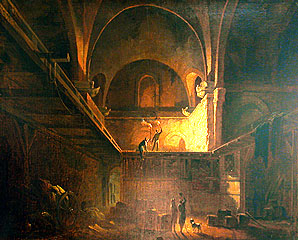- Home
- The city
- The early Roman city
- The Cluny baths
- A monument on the Parisian landscape
The cooper of the Palace of the Julian Baths.
Hubert Robert, ca. 1785.
Peinture conservée au Musée Carnavalet.
This monument, which has been continually occupied since it was built, is mentioned in medieval texts. It was the subject of many commentaries, and its massive opus vittatum mixtum walls and high vaulting interested both scholars and historians. Very early on, it also stimulated the imaginations of artists-engravers and painters-who created many representations of it, the earliest of which dates back to the 17th century. Idealised images of Antiquity gave way to romantic descriptions extolling the charm of ruins, which in turn gave way to more realistic presentations of the evolution of the building into a cooper's warehouse.
The building's final metamorphosis took place in the 19th century, when it became a museum of the Roman baths themselves, and a national museum housing medieval collections.
